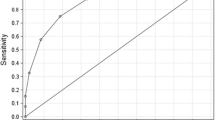Abstract
Background
Aim of our study was to assess the ability of computed tomography to distinguish between an intussusception with a lead-point from one without it.
Methods
Approval was granted by the Institutional Review Board. Ninety-three consecutive patients diagnosed with an intussusception on abdominal CT were classified with or without lead-point by surgery, clinical or radiological follow-up. Two radiologists blinded to the classification independently reviewed the CT images for predefined predictive variables.
Results
Non-lead-point intussusception was shorter in length (mean 4.9 vs. 11.1 cm for Reader 1 (R1); mean 4.0 vs. 8.9 cm for Reader 2 (R2), respectively, P < 0.001), smaller in axial diameter (mean 3.0 vs. 4.8 cm for R1; mean 2.8 vs. 4.4 cm for R2, P < 0.001, respectively), less likely associated with obstruction (P = 0.002 R1; P = 0.039 R2) and infiltration (P < 0.001 for R1, P = 0.003 R2) than lead-point intussusception.
Conclusions
Abdominal CT is helpful in distinguishing between an intussusception with a lead-point from one without a lead-point. Length, axial diameter, and their product, as well as obstruction and infiltration, all suggest the presence of a lead-point. Analysis of CT findings can reduce unnecessary imaging follow-up or operation.




Similar content being viewed by others
References
Azar T, Berger DL (1997) Adult intussusception. Ann Surg 226:134–138
Warshauer DM, Lee JK (1999) Adult intussusception detected at CT or MR imaging: clinical-imaging correlation. Radiology 212:853–860
Stubenbord WT, Thorbjarnarson B (1970) Intussusception in adults. Ann Surg 172:306–310
Felix EL, Cohen MH, Bernstein AD, Schwartz JH (1976) Adult intussusception; case report of recurrent intussusception and review of the literature. Am J Surg 131:758–761
Styles RA, Larsen CR (1983) CT appearance of adult intussusception. J Comput Assist Tomogr 7:331–333
Agha FP (1986) Intussusception in adults. AJR Am J Roentgenol 146:527–531
Reijnen HA, Joosten HJ, de Boer HH (1989) Diagnosis and treatment of adult intussusception. Am J Surg 158:25–28
Begos DG, Sandor A, Modlin IM (1997) The diagnosis and management of adult intussusception. Am J Surg 173:88–94
Catalano O (1997) Transient small bowel intussusception: CT findings in adults. Br J Radiol 70:805–808
Zissin R, Gayer G, Konen O, Shapiro-Feinberg M (2000) Transient colocolic intussusception. Clin Imaging 24:8–9
Gayer G, Zissin R, Apter S, Papa M, Hertz M (2002) Pictorial review: adult intussusception-a CT diagnosis. Br J Radiol 75:185–190
Tan KY, Tan SM, Tan AG, Chen CY, Chng HC, Hoe MN (2003) Adult intussusception: experience in Singapore. ANZ J Surg 73:1044–1047
Choi SH, Han JK, Kim SH, et al. (2004) Intussusception in adults: from stomach to rectum. AJR Am J Roentgenol 183:691–698
Kim YH, Blake MA, Harisinghani MG, et al. (2006) Adult intestinal intussusception: CT appearances and identification of a causative lead point. Radiographics 26:733–744
Lvoff N, Breiman RS, Coakley FV, Lu Y, Warren RS (2003) Distinguishing features of self-limiting adult small-bowel intussusception identified at CT. Radiology 227:68–72
Cohen MD, Lintott DJ (1978) Transient small bowel intussusception in adult coeliac disease. Clin Radiol 29:529–534
Knowles MC, Fishman EK, Kuhlman JE, Bayless TM (1989) Transient intussusception in Crohn disease: CT evaluation. Radiology 170:814
Mapagu C, Lam A, Martin HC, Fitzgerald DA (2003) Intermittent intussusception. J Paediatr Child Health 39:147–148
Kim JH (2004) US features of transient small bowel intussusception in pediatric patients. Korean J Radiol 5:178–184
Sandrasegaran K, Kopecky KK, Rajesh A, Lappas J (2004) Proximal small bowel intussusceptions in adults: CT appearance and clinical significance. J Abdom Imaging 29:653–657
Zeebregts CJ, Prevo RL, Klaase JM (2004) Jejunojejunal intussusception secondary to adenocarcinoma. Am J Surg 187:450–451
Donovan AT, Goldman M (1982) Computed tomography of ileocecal intussusception: mechanism and appearance. J Comput Assist Tomogr 6:630–632
Iko BO, Teal JS, Siram SM, Chinwuba CE, Roux VJ, Scott VF (1984) Computed tomography of adult colonic intussusception: clinical and experimental studies. AJR Am J Roentgenol 143:769–772
Skaane P, Schindler G (1985) Computed tomography of adult ileocolic intussusception. Gastrointest Radiol 10:355–357
Ross GJ, Amilineni V (2000) Case 26: jejunojejunal intussusception secondary to a lipoma. Radiology 216:727–730
Fujimoto T, Fukuda T, Uetani M, et al. (2001) Unenhanced CT findings of vascular compromise in association with intussusceptions in adults. AJR Am J Roentgenol 176:1167–1171
Strouse PJ, DiPietro MA, Saez F (2003) Transient small-bowel intussusception in children on CT. Pediatr Radiol 33:316–320
Takeuchi K, Tsuzuki Y, Ando T, et al. (2003) The diagnosis and treatment of adult intussusception. J Clin Gastroenterol 36:18–21
Merine D, Fishman EK, Jones B, Siegelman SS (1987) Enteroenteric intussusception: CT findings in nine patients. AJR Am J Roentgenol 148:1129–1132
Doi O, Aoyama K, Hutson JM (2004) Twenty-one cases of small bowel intussusception: the pathophysiology of idiopathic intussusception and the concept of benign small bowel intussusception. Pediatr Surg Int 20:140–143
Weilbaecher D, Bolin JA, Hearn D, Ogden Wn (1971) Intussusception in adults. Review of 160 cases. Am J Surg 121:531–535
Brayton D, Norris WJ (1954) Intussusception in adults. Am J Surg 88:32–43
Nagorney DM, Sarr MG, McIlrath DC (1981) Surgical management of intussusception in the adult. Ann Surg 193:230–236
Strobl PW, Warshauer DM (1995) CT diagnosis of celiac disease. J Comput Assist Tomogr 19:319–320
Author information
Authors and Affiliations
Corresponding author
Rights and permissions
About this article
Cite this article
Tresoldi, S., Kim, Y.H., Blake, M.A. et al. Adult intestinal intussusception: can abdominal MDCT distinguish an intussusception caused by a lead point?. Abdom Imaging 33, 582–588 (2008). https://doi.org/10.1007/s00261-007-9328-8
Published:
Issue Date:
DOI: https://doi.org/10.1007/s00261-007-9328-8




